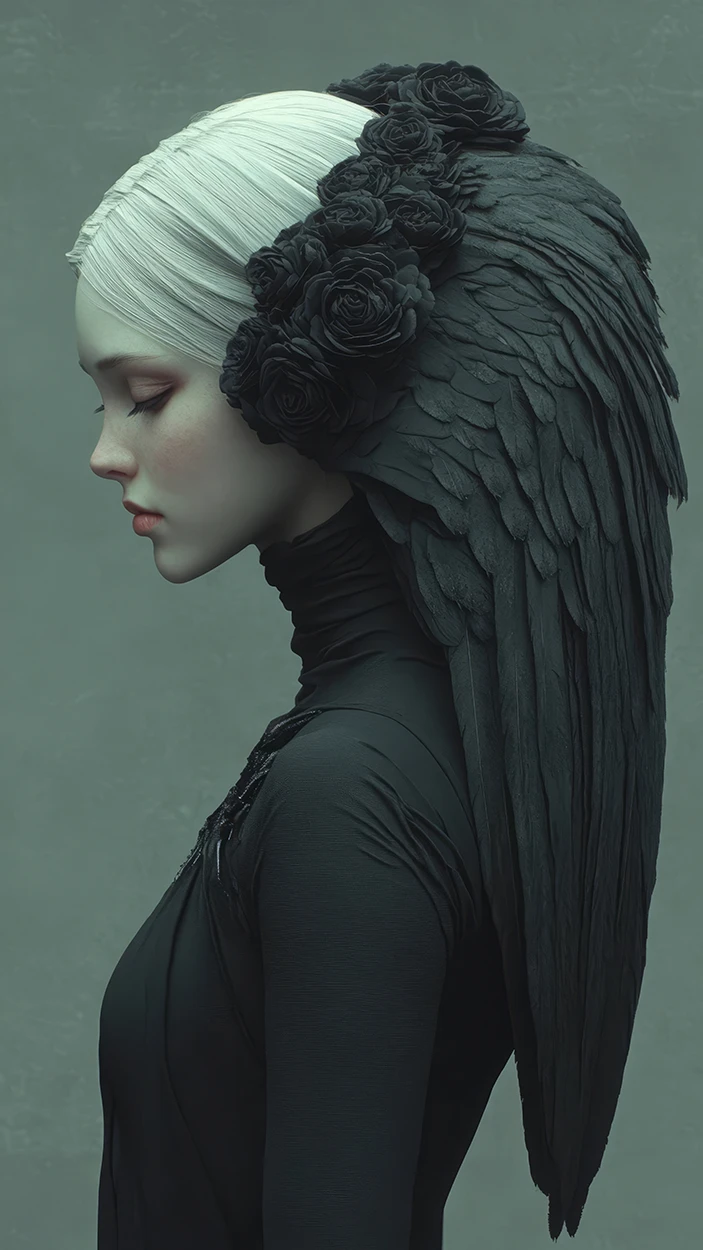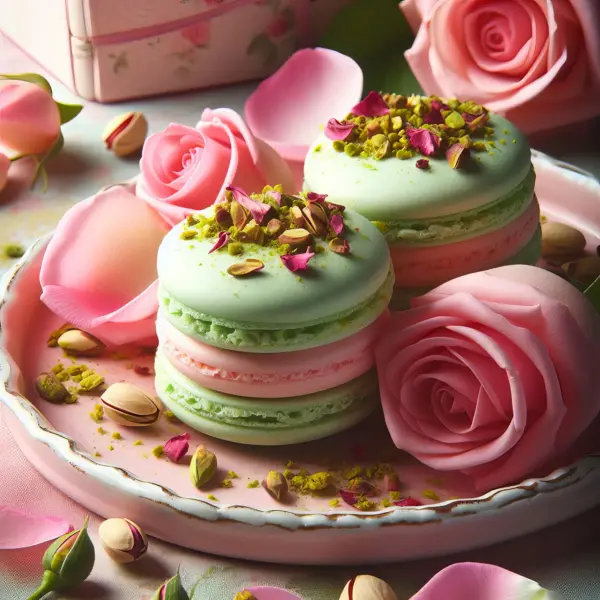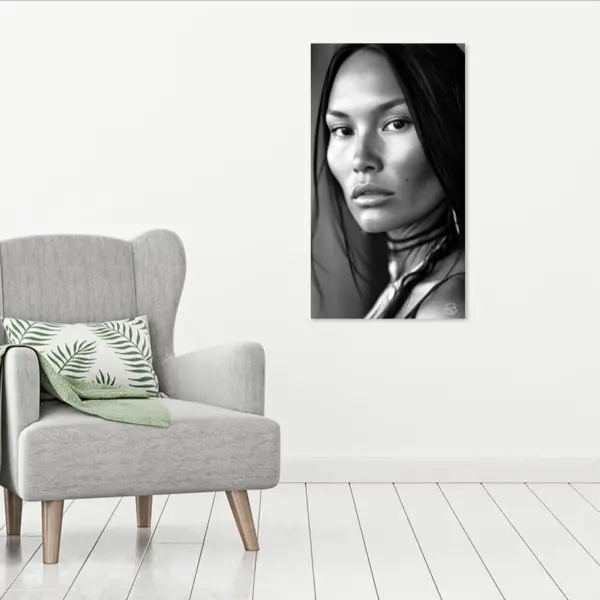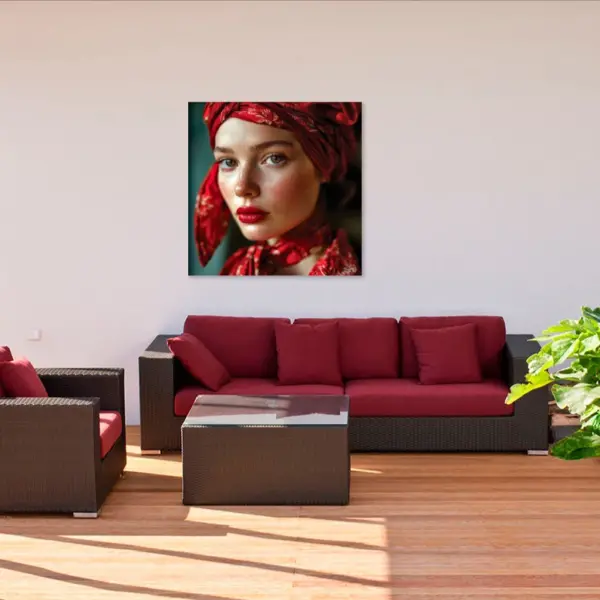Queen of the Black Crow
In “Queen of the Black Crow,” the artist crafts a hauntingly elegant portrait of a figure draped in an aura of quiet power and melancholic grace. The woman, with her alabaster skin and serene profile, stands out against a muted, almost ethereal backdrop. Her downcast eyes and delicately parted lips suggest a contemplative state, perhaps hinting at the burden of authority or the loneliness that accompanies her regal title.
The most striking element is the crown of black roses and feathers that adorns her head, merging with the sleek black dress that envelops her. The texture of the feathers is meticulously detailed, evoking the dark, mysterious presence of crows. These birds, often symbols of death, transformation, and the unknown, seem to flow naturally from her form, as if she herself embodies these themes. The way the feathers curve along her silhouette gives her an almost otherworldly presence, suggesting that she is both part of the natural world and above it, commanding forces that most cannot comprehend.
The contrast between the woman’s ghostly pale hair and the deep black roses adds a layer of stark duality. The white, symbolic of purity or innocence, opposes the darkness of the feathers and flowers, which represent death, mystery, or power. This tension between light and dark encapsulates the essence of the queen’s reign—one that is shrouded in shadows, yet retains a sense of beauty and delicacy. Her regal posture, head held in quiet dignity, suggests she is aware of this balance and carries the weight of it with grace.
The artist subtly incorporates Gothic elements into the composition, with the high-necked dress clinging to her slender form, reminiscent of Victorian fashion. The black roses, often associated with mourning or farewell, further emphasize the sorrowful undertone that accompanies her position. Yet, despite the darkness surrounding her, there’s a softness in her expression, a quiet acceptance of the crown she bears. This duality—of power and fragility, life and death—is what gives the artwork its profound emotional depth.
This piece would hold a unique presence in various settings. In a modern gallery, it could inspire reflections on power, femininity, and mortality, creating a space for introspection. In a more intimate or personal space, it would evoke an atmosphere of quiet strength, imbuing the room with an almost sacred quality. The muted tones and symbolic richness make it adaptable to minimalist or contemporary designs, where its subtlety and depth would come alive in the context of a quiet, contemplative environment. The “Queen of the Black Crow” has the power to fill any space with a sense of mystery and silent majesty, resonating with those who seek to explore the tension between light and darkness, fragility and strength.
Looking to purchase art from our online gallery? Follow these simple steps:
- Find the artwork you love and click on it. If you're considering multiple pieces, click "ADD TO CART." If you've decided on just one, click "BUY NOW."
- Feel free to keep browsing our gallery and adding more artwork to your cart.
- To review your selected artworks, click on the shopping cart icon in the top right corner. You can remove any items if you change your mind.
- When you're ready to complete your order, click "CHECKOUT" at the top right corner of the screen.
- After your purchase, you'll receive a download link. Additionally, we'll send the link to your email address for easy access.
Wondering how to pay for your selected artworks? Here's how:
Simply click the "CHECKOUT" button to finalize your order, and then select your preferred payment method. We offer the following options:
- Credit cards (Stripe)
- PayPal
- Bank transfer (Upon placing your order, we'll send you an invoice. Once the invoice is paid in full, we'll proceed to ship the artwork.)
Is the payment secure?
- Rest assured, our payment system is highly secure. We exclusively process transactions that are 3D secured to combat fraud.
- Additionally, as an added measure of protection, we may request identity verification to prevent unauthorized use of your credit card.
Is it possible to request a commissioned artwork with specific size and color preferences?
- Interested in commissioning an artwork of a specific size or color? While not all artists offer commissions for paintings and sculptures, you can request a customized size print.
- Feel free to reach out to us and share your requirements if you're interested in commissioning an artwork. We're here to assist you.
Shipping & Returns?
Purchase Terms of Agreement
The purchase of digital products, including EPS, PDF, AI or JPG downloads and online material is subject to the following terms and conditions. Consumers are advised to review carefully before making any purchase
Payment + Refund Policy
All transactions for purchase of intangible products, pdf, eps, ai or jpg downloads, resource material, and online content are made through payment gateways such as PayPal or Stripe that use SSL encryption. These payment gateways are safe and secure for using all types of credit cards and debit cards in different countries and your details are not stored during this process.
Since your purchase is a digital product, it is deemed “used” after download or opening, and all purchases made on www.daymara.com (Swiss Llc Ltd.) are non-refundable or exchangeable. However, we will provide a full refund if the resolution, print quality, if you have received a product that differs from the product image shown to you at the time of purchase or if there are file errors. Since the products made available here are intangible, there is a strict no refund policy.
Daymara (Swiss Llc Ltd.) reserves the right to amend any information, including but not limited to prices, technical specifications, terms of purchase and product or service offerings without prior notice.
Delivery of Goods and Services
If you do not receive the digital product link upon purchasing, you can immediately contact [email protected] with your transaction/payment details to ensure your product is delivered as soon as possible.
Delivery Process
- The product you purchased is a print-ready visual design product.
- A download link of the product will be presented to you after the purchase. You will be able to download and use the work using this link.
- Delivery is provided with a downloadable link after purchase. Also, no physical product will be sent. Please make sure you understand this point. If you have any questions, please write to us from the contact section.
- Each product may be in different sizes. The maximum printable size of the product is written on the page of the product. It is naturally possible to print larger than this size. But in this case, pixel distortions can be seen.
- Since a downloadable link is offered to you after purchasing the product, the product you have purchased is deemed to have been delivered.
- It is not possible to return the delivered products or cancel the order after this stage. However, we will provide a full refund if the resolution, print quality, if you have received a product that differs from the product image shown to you at the time of purchase or if there are file errors.
- If you encounter a problem with the file you downloaded, please do not hesitate to contact us. Your request will be answered within 1 hour at the latest.



 70-140cm (27.5″≈55″) Printable
70-140cm (27.5″≈55″) Printable

